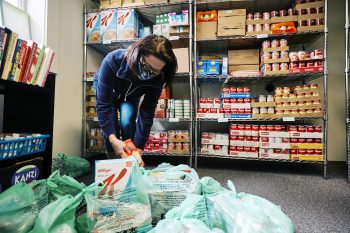Student-led Bounty of the Bridgers food pantry serves MSU community
by Meaghan MacDonald-Pool, MSU News Service
BOZEMAN — Two weeks before leaving Montana in the summer of 2017, Teale Harden stood in the basement of Montana State University’s Office of Health Advancement. The small space would become the home of the Bounty of the Bridgers campus food pantry — a project MSU students like her had worked for years to create.
Harden, a graduate of the Sustainable Food and Bioenergy Systems Program in the College of Education, Health and Human Development, dedicated the final two years of college to researching and implementing a program to address food insecurity on MSU’s campus.
In that bare basement, Harden could see the finish line for the project: a permanent location.
“I was looking at the basement and I felt hopeful the pantry was going to happen,” said Harden, who now is the program manager of the Alameda Food Bank in Alameda, California. “The conversation left the classroom and was actually being talked about and taken seriously by people in departments outside our little enclave. And it felt very satisfying to see the project make that jump.”
Bounty of the Bridgers seeks to combat food waste and food insecurity affecting MSU students, faculty and staff, offering supplemental and emergency food assistance to anyone in need. The pantry spans two locations: its permanent spot in the OHA basement and a pop-up pantry on Saturdays in Family and Graduate Housing, both providing perishable and non-perishable options.
Since 2017, the program has distributed more than 27,500 pounds of food. The pantry serves an average of 75 MSU households per month and has helped 2,550 MSU community members since 2017. Its volunteers have collectively served over 1,050 hours.
The pantry also has a food rescue arm. Its volunteers visit grocery stores across Bozeman and collect produce donations to help reduce potential waste. This year, they have rescued more than 2,500 pounds of food.
The food pantry began as an undergraduate research project by Stephanie Johnson, a health and human development graduate, who created a survey aimed at determining how many students on campus identified as food insecure. According to the U.S. Office of Disease Prevention and Health Promotion, food insecurity is defined as the “disruption of food intake or eating patterns because of lack of money and other resources.”
The results of her four-year study, completed in 2015, found that 38.8% of respondents identified as food insecure, compared to 14.1% in Montana and 14.5% in the U.S. Johnson’s project stopped at the statistics, but inspired the 2015 fall semester Sustainable Food and Bioenergy Systems capstone course to pick up where she left off. The course encourages seniors to choose a real-world problem and spend the semester developing a solution that will positively impact the food system.

Lesley Wallace, program manager of Resilience Initiatives for Students to Excel (RISE) at Montana State University, stocks shelves and prepares pick-up orders of food staples at the Bounty of the Bridgers food pantry on campus, Tuesday, Oct. 27, 2020, in Bozeman, Mont.
MSU Photo by Adrian Sanchez-Gonzalez
The capstone class’s own surveys found there was an opportunity to increase the available food resources for students and their families by implementing a campus food pantry resource network.
As the project’s instigators graduated, Mary Stein, Sustainable Food and Bioenergy Systems program leader and capstone course instructor beginning in 2016, suggested the next capstone course continue the work. More than a dozen students tackled barriers to make the pantry become a reality, including food safety and regulatory issues.
“I loved that this project was real world, and that it provided opportunity for students to be both aspirational and practical at the same time,” Stein said. “For example, the students had to be sure the campus food pantry followed all food safety rules and regulations and therefore worked closely with the campus sanitarian, a relationship that is still ongoing today. I was super proud of them for tackling that aspect of the project.”
Harden played a major role in the 2016 group project and took extra steps to build momentum for the pantry so it would continue after her own graduation. She recruited younger students to join the Food Resource Council student organization to help bring the pantry to fruition. The organization, which became Bounty of the Bridgers student organization, was made up of students from various disciplines, which Harden said was imperative so students from all academic backgrounds could bring new perspectives and address potential blind spots. In February 2017, Harden, with help from Stein, also applied for an AmeriCorps VISTA grant, which would give the pantry a full-time employee to help get it started and running. In July 2017, the pantry project was granted a three-year AmeriCorps VISTA grant.
Then, after two years with the VISTA position, Bounty of the Bridgers found university funding through joint efforts with the Associated Students of MSU and University Health Partners. Additional funding now comes from the Office of Student Engagement, the Office of Health Advancement, Northwest Farm Credit Services, and donations from the community.
Rachel Juel, a 2019 MSU graduate from the Department of Chemistry and Biochemistry in the College of Letters and Science, started as a volunteer manager for the pantry in 2017 and took over as the VISTA service member in charge of the pantry the following year. A native of Scobey, Juel is the daughter of a farmer and had spent much of her life connected to the food system, where she developed a passion for eliminating food waste.
While a senator for ASMSU, Juel helped secure student Senate support for the pantry, and in her VISTA position, she helped develop a strong relationship with the Gallatin Valley Food Bank and worked with the state to have Bounty of the Bridgers become a registered food bank.
“I am so proud of what the Bounty of the Bridgers has become,” said Juel, who is currently getting her master’s in public health at Cambridge University in the United Kingdom. “You don’t have to go overseas to solve a problem. There is a misconception around service that taking service trips and going to a new country is the only way. But at the same time, you can do this at your school. You don’t have to look that far to find a role that needs filling and I think that’s a really critical part of these students working at the pantry.”
Marci Torres, director of Office of Health Advancement, said she hopes the pantry can one day offer more options for clients and help more people. Meeting the food needs of MSU students, she said, also helps ensure they are academically successful.
“Nutrition is so directly tied to the success of a student in the classroom. If you’re stressed out because you don’t know where your next meal is coming from or you’re not getting enough nutrition to focus, it just snowballs,” said Torres. “That’s why students are here, to learn and go on to be successful and give back to somebody else who’s food insecure when they are in a place where that is no longer their situation.”
Due to the pandemic, the pantry’s need is higher than ever, according to Torres. She said that the number of clients has increased since March. The pantry is currently running without volunteers to ensure the safety of staff and clients, offering prepackaged boxes of food for contactless pick up.
For those who need the pantry, appointments can be made at https://www.signupgenius.com/go/9040e4ba8aa23a6f94-bounty1. The pantry’s permanent location is open Wednesdays 11 a.m. to 4 p.m. and Thursdays 4 to 6 p.m. The pop-up pantry in Family and Graduate Housing runs on Saturdays 1 to 3 p.m. More information can be found at http://www.montana.edu/oha/bounty-of-the-bridgers.html. •






